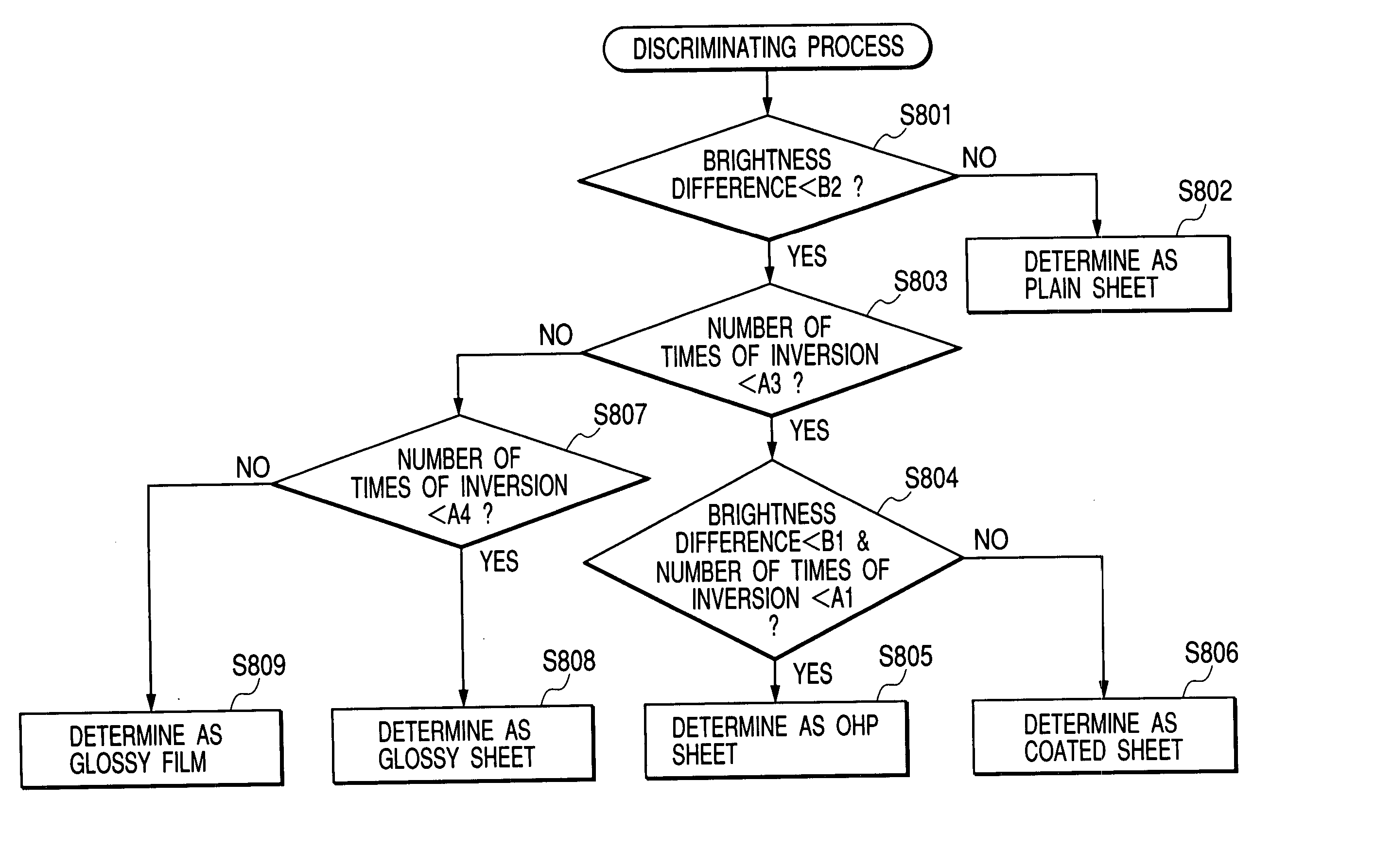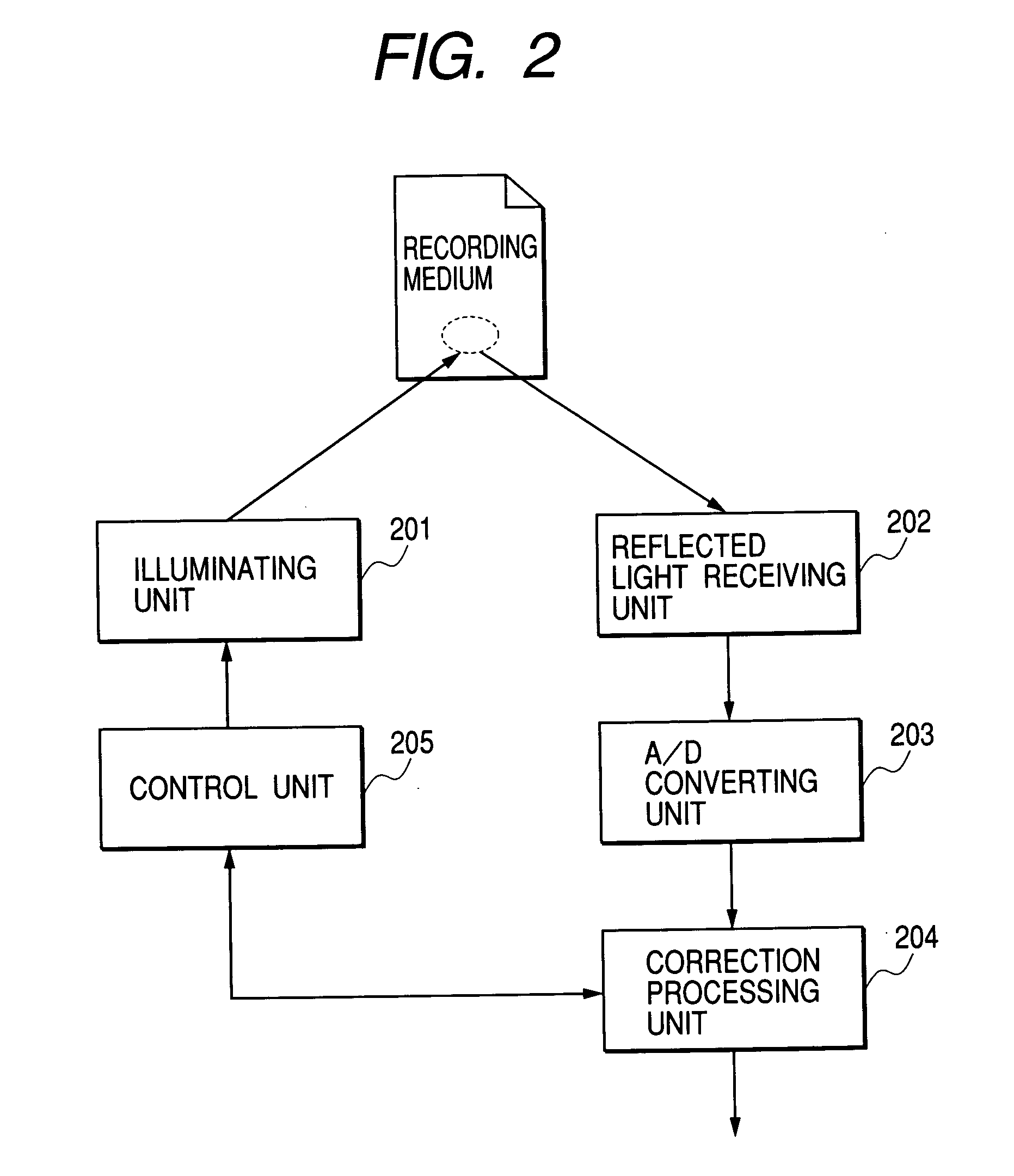Discriminating method for recording medium and recording apparatus
a recording medium and discrimination method technology, applied in the direction of image enhancement, digital output to print units, instruments, etc., can solve the problems of not being able to distinguish plain sheets from coated sheets, user may not obtain the quality of recorded images as desired in some cases, and difficulties, so as to improve discrimination accuracy, improve the quality of recording images, and improve the effect of discrimination
- Summary
- Abstract
- Description
- Claims
- Application Information
AI Technical Summary
Benefits of technology
Problems solved by technology
Method used
Image
Examples
first embodiment
[0066] (First Embodiment)
[0067] Hereunder, with reference to the accompanying drawings, the detailed description will be made of a first embodiment that materializes the present invention.
[0068] FIG. 1 is a functional block diagram that shows a method for discriminating recording medium in accordance with the first embodiment.
[0069] In FIG. 1, a reference numeral 101 designates an image information-generating unit that generates image information from any (or arbitrary) fine area on the surface of a recording medium. The image, which is generated in this image information-generating unit, is formed by plural pixels having the brightness value larger than the binary. Here, it is assumed that such image is the aggregation of pixels having 8-bit brightness information. At this time, it is not needed to give heed to whether each pixel has color information of RGB or not. For the present embodiment, the image information is generated by the component of diffused reflection light, and eac...
second embodiment
[0139] (Second Embodiment)
[0140] Hereunder, with reference to the accompanying drawings, the description will be made of a second embodiment of the present invention.
[0141] The recording medium-discriminating method that materializes the present embodiment is characterized in that whereas the first embodiment uses the brightness difference and the number of inversions after the execution of the binarizing process for discriminating the kind of recording medium, this embodiment is designed to discriminate the kind of recording medium by use of arithmetic mean value and the amount of run-length codes. Therefore, the description will be made centering on such event.
[0142] FIG. 12 is a functional block diagram that shows the recording medium-discriminating method in accordance with the second embodiment.
[0143] A reference numeral 1201 designates an image information-generating unit that generates image information form any small area on the surface of a recording medium. As in the case ...
third embodiment
[0170] (Third Embodiment)
[0171] Hereunder, with reference to the accompanying drawings, the description will be made of a third embodiment of the present invention.
[0172] The recording medium-discriminating method that materializes the present embodiment is characterized in that the kind of recording medium are discriminated by use of the rightness difference and the isolated number of pixels. Therefore, the description will be made centering on such event. The process flow and the flow of discrimination are almost the same as those of the first embodiment, and the description thereof will be omitted.
[0173] FIG. 18 is a functional block diagram that shows the recording medium-discriminating method in accordance with the third embodiment.
[0174] A reference numeral 1801 designates an image information-generating unit that generates image information form any small area on the surface of a recording medium. The process in which the image information is generated from the diffused refle...
PUM
 Login to View More
Login to View More Abstract
Description
Claims
Application Information
 Login to View More
Login to View More - R&D
- Intellectual Property
- Life Sciences
- Materials
- Tech Scout
- Unparalleled Data Quality
- Higher Quality Content
- 60% Fewer Hallucinations
Browse by: Latest US Patents, China's latest patents, Technical Efficacy Thesaurus, Application Domain, Technology Topic, Popular Technical Reports.
© 2025 PatSnap. All rights reserved.Legal|Privacy policy|Modern Slavery Act Transparency Statement|Sitemap|About US| Contact US: help@patsnap.com



